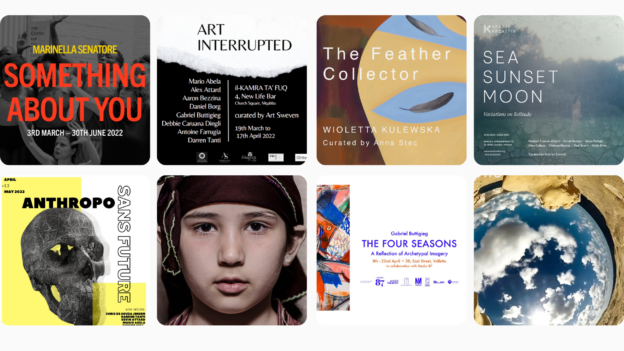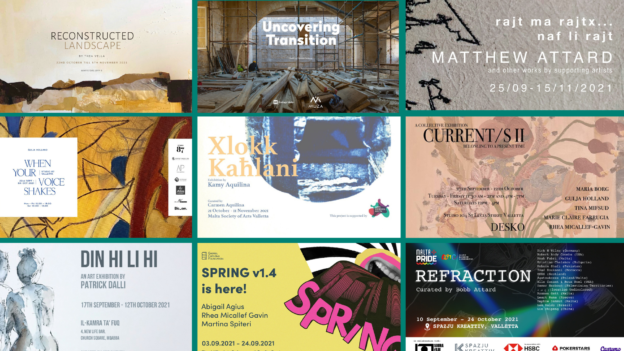Maltese Everlasting, Inigo Taylor tells us more about his ongoing exhibition of our native countryside

An exhibit now showing at Studio 87 in Valletta, is that of artist Inigo Taylor’s Maltese, Everlasting. Thus far, it is his second solo show, where he ventures into the topic of our Maltese Landscape. The documented photographs occupying the space, may at first seem straightforward, yet these captures unify untouched nature spaces and those affiliated with man-made interference. In time and space, these analogue photographs present our landscape for in the now and what it may become if we do not safeguard it. At the start of the pandemic, the artist’s change in style coincided with the birth of his daughter Rosie. Her birth is an association that Taylor deeply accredits to his work and he tells us more about it in the conversation below.

Wied Qlejgħa by Inigo Taylor
What can you tell us about Maltese, Everlasting, and what inspired this exhibition?
The photographs that makeup Maltese, Everlasting represent for me a big change in direction. In spring 2020, the birth of my daughter Rosie (who is Maltese on her mother’s side) had me feeling grounded in Malta, in the sense that my life became linked to the islands profoundly. Before this exhibit, I had predominately photographed Malta from a social point of view in which people and the lived environment were the focus of my work. With the rapid and monumental change in Malta from 2010 onward, it was an opportunity to see the country change dramatically. The body of work that I have related to this subject is The Colour of Limestone, currently unpublished. When the prospect of fatherhood began to sink in, I started to consider the body of work I had made up until that point and what it may mean in the future to Rosie. Would it be of value? Would it instill in her a sense of who she was and where she was from?. I realised that it was very important for me to make work around the subject of the land Rosie would belong to. In the winter of 2019, I made a small project in which I chose topics of landscape and nature, specifically looking at the Widien (valleys). After ten years of living here and a lifetime of summer holidays, it was the winter of 2019 when I really fell in love with Malta. Like any love, it isn’t easy and often complicated. The overwhelming human impact on our landscape like much of the planet is more often than not a tragedy unfolding in front of us. Maltese, Everlasting is my attempt to acknowledge the beauty, truth, and verdant of our shared Maltese landscape and the light that acknowledges it.
The exhibit is a display of black and white analogue photographs. Why did you choose this medium?
I made the decision when moving to Malta to work in colour. I became entrenched in colour photography and I started to use flash to enhance the already overpowering sun. I wanted to convey a feeling of detachment in my pictures with a clinical element. Working with colour and using a digital camera felt right. I would then apply minimal post-processing with the aim of representing a modern Malta. A Malta still holding on to its Mediterranean past. The event of the pandemic felt like an appropriate time to call it a day with the way I was working and with this mentioned project altogether. In April 2020, I was ready to return to my practice of taking black and white photographs and perhaps, more importantly, to film. I decided to start using a medium format camera to produce good size negatives as to create detailed images. As important as the techniques of photography are and the choice of camera etc, it is about taking a photograph, leaving some time and going back to it and this is by no means resting on your laurels but choosing to continue and make work. At certain times you do not know where it’s going and that is the benefit of using pre-digital technology. I often see my work months after it is made, which has become crucial to my process. With regards to why black and white, I can’t really answer that question simply but what I would say is that I am fascinated by the play of light, which is more effective than colour photography.

Xagħra by Inigo Taylor
What is the takeaway from this project, and how has it affected your practice?
As nauseating as it may sound, the first step was to consider nature as my true subject. It has made me realise how important the trees, valleys, caves, and Xaghri are to me. The Maltese landscape is my home, even above my native England. I consider my time here a huge privilege and the photographs are the way I try to honour it.

Burmarrad by Inigo Taylor
What's next in plan for Inigo Taylor?
Maltese, Everlasting was a brief survey, to lead me to projects that would allow me to acknowledge as much of the island as my legs and eyes will hopefully allow me to. The photographic works were made roughly, in a year. I had noticed Eucalyptus trees appearing in a large number of my pictures. Is-Sigra Tal Gammiem is the name given to the Eucalyptus by Maltese hunters which translates to the tree of the turtle doves. When I read that phrase I instantly knew it was my next project. The political and cultural history of the tree and the way it has become ubiquitous in the landscape in a relatively short period of time led me to photograph them for the last year. There is no doubt that Eucalyptus is a problematic species in the Maltese context. Their incredible resilience and resourcefulness are to me awe-inspiring. They are known for their dominance over native species but to me, it was important to treat them separate from the rest, with reverence and respect. The photographs point to what we as humans can safeguard and what plants, trees, and animals cannot. Once the exhibition comes to an end, I will then start my journey towards publishing my first book.
Opening hours: Monday to Thursday: 16.00 – 19.00, Friday: 16:00 – 22:00
Artist’s website: https://inigotaylor.myportfolio.com/
Instagram: https://www.instagram.com/inigotaylor88/





Responses